Li S.Z., Jain A.K. (eds.) Encyclopedia of Biometrics
Подождите немного. Документ загружается.


exploits the 3D geometric information of the human
face. It employs data from 3D sensors that capture
information about the shape of a face. Recognition
is based on matching metadata extracted from the 3D
shapes of faces. In an identification scenario, the match-
ing is one-to-many, in the sense that a probe is
matched against all of the gallery data to find the
best match above some threshold. In an authentication
scenario, the matching is one-to-one, in the sense that
the probe is matched against the gallery entry for a
claimed identity, and the claimed identity is taken to be
authenticated if the quality of match exceeds some
threshold. 3D face recognition has the potential to
achieve better accuracy than its 2D counterpart by
utilizing features that are not sensitive in lighting con-
ditions, head orientation, differing facial expressions,
and make-up.
Introduction
In recent years, among the many biometric modalities,
the face has received the most interest. Not only is face
recognition one of the most widely accepted modal-
ities, but advances in processing power have allowed
the development of more complex algorithms while
still providing a rapid response to queries. Face recog-
nition requires no contact with the subject, thus being
more easily accepted by the public compared to other
biometrics such as fingerprints.
Face recognition has been traditionally performed
using 2D (visible spectrum) images, while hybrid
approaches have used infrared images and 3D geome-
try. Infrared face recognition has not been wid ely
adopted due to the high cost of infrared cameras nec-
essary to acquire data. In contrast, the cost of 3D
scanners has dropped significantly, so it has become
feasible to deploy them in the field, and therefore, the
interest in developing algorithms that use 3D data has
increased.
The main reason for using information from 3D
data as a biometric is that the data acquired by 3D
acquisition devices are invariant to pose and light-
ing conditions, these being the major challenges with
which face recognition algorithms must cope. More-
over, image-based face recognition algorithms are more
susceptible to impostors. Indeed, an impostor may use
a printout of an image of a subject allowed to enter a
facility in order to break in. To avoid this, the face
recognition algorithm must be coupled with liveness
test algorithms. Attempting such an attack on a system
based on 3D data would be much more difficult, since
the attackers would need to obtain an accurate 3D
model (sculpture) of the person whom they would
like to impersonate.
The challenges of a 3D face recognition system are
the following:
Accuracy gain: A significant gain in accuracy with
respect to 2D face recognition systems must justify
the introduction of 3D recognition systems.
Efficiency: 3D capture devices generate substantially
more informati on than 2D came ras. Using this
large volume of information is expensive in terms
of computation time and storage requirements.
Therefore, the algorithms developed need to be
efficient both in time and space, by using the
appropriate metadata.
Automation: The system must be completely auto-
mated. It is therefore not acceptable to assume user
intervention, such as for the location of key land-
marks in a 3D facial scan.
Capture devices: 3D capture devices were mostly
developed for medical and other low-volume appli-
cations and suffer from a number of drawbacks,
including artifacts, small depth of field, long acqui-
sition time, multiple types of output, and high price.
A deployable 3D face recognition system must be
able to process several persons a minute, if it is to
be used in high-traffic areas.
Testing databases: There are few large databases of
3D faces which are widely accepted for objectively
testing the performance of 3D face recognition
systems. More such databases are needed to ensure
proper testing of the system.
Robustness: The system must perform robustly and
reliably under a variety of conditions (e.g., lighting,
pose variation, facial feature variation).
An Integrated 3D Face Recognition
System
The authors have developed a fully automatic system
[1] which is capable of using 3D data as input, along
with a facial model, to output metadata information.
The metadata are then used for recognition. The facial
model has been constructed only once, and it can
handle objects belonging to the same class (i.e., faces).
Once the data are acquired, the model is fitted to the data
330
F
Face Recognition, 3D-Based
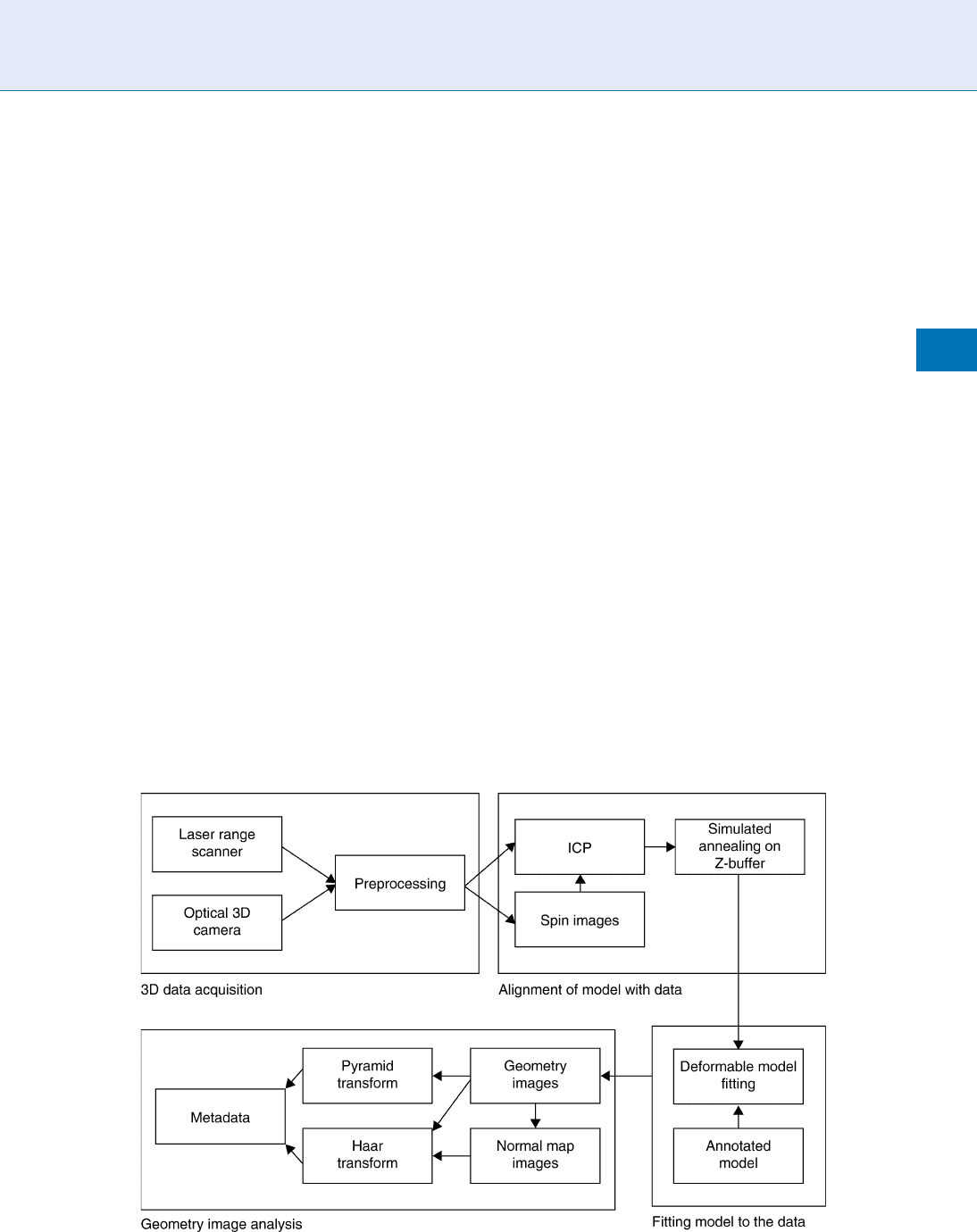
and used to generate a geometry image and a normal
map, which are transformed into the wavelet domain.
Only a small number of the wavelet coefficients are
stored as metadata and used for comparison.
Our recognition procedure can be divided into two
distinct phases: enrollment and recognition.
Enrollment: Raw data acquired by the 3D scanner
are converted to metadata and stored in a database
(gallery). The following steps describe the conversion
from raw data to metadata (Fig. 1):
1. Acquisition: The sensor acquires raw data which
are converted into a polygonal representation.
A preprocessing step takes place to alleviate
scanner-specific issues.
2. Alignment: The data are aligned into a unified coor-
dinate system using a multi-stage alignment method.
3. Deformable model fitting : The
▶ annotated face
model (AFM) is fitted to the data.
4. Metadata generation: Geometry and normal map
images are derived from the fitted model and wave-
let analysis is applied to extract a reduced set of the
most significant coefficients.
Recognition: Metadata extracted from a face probe
(using the same steps as for enrollment) are directly
compared with metadata retrieved from the database
gallery using a distance metric.
Data Acquisition and Preprocessing
In general, the current generation of scanners outputs
either a range image or 3D polygonal data. The pur-
pose of preprocessing the data is the elimination of
any sensor-specific issues and the unification of data
from different sources into a common format ( Fig. 2).
The preprocessing consists of the following filters that
operate on both the native representations and on
1-neighbors, and are applied in the given order:
Median cut: This filter removes spikes from data
acquired by using laser scanners.
Hole filling: Eliminates holes produced by laser
scanners in certain areas such as eyes and eye brows.
Smoothing: A smoothing filter is applied to remove
white noise.
Subsampling: The deformable model fitting effec-
tively resamples the data, making the method less
sensitive to data resolution without losing perfor-
mance in the recognition ph ase. Subsampling fur-
ther reduces the noise in the geometry.
Annotated Face Model
Our approach introduces an AFM, which is con-
structed only once and is used in the alig nment, fitting,
Face Recognition, 3D-Based. Figure 1 Enrollment phase of the proposed integrated 3D face recognition system.
Face Recognition, 3D-Based
F
331
F
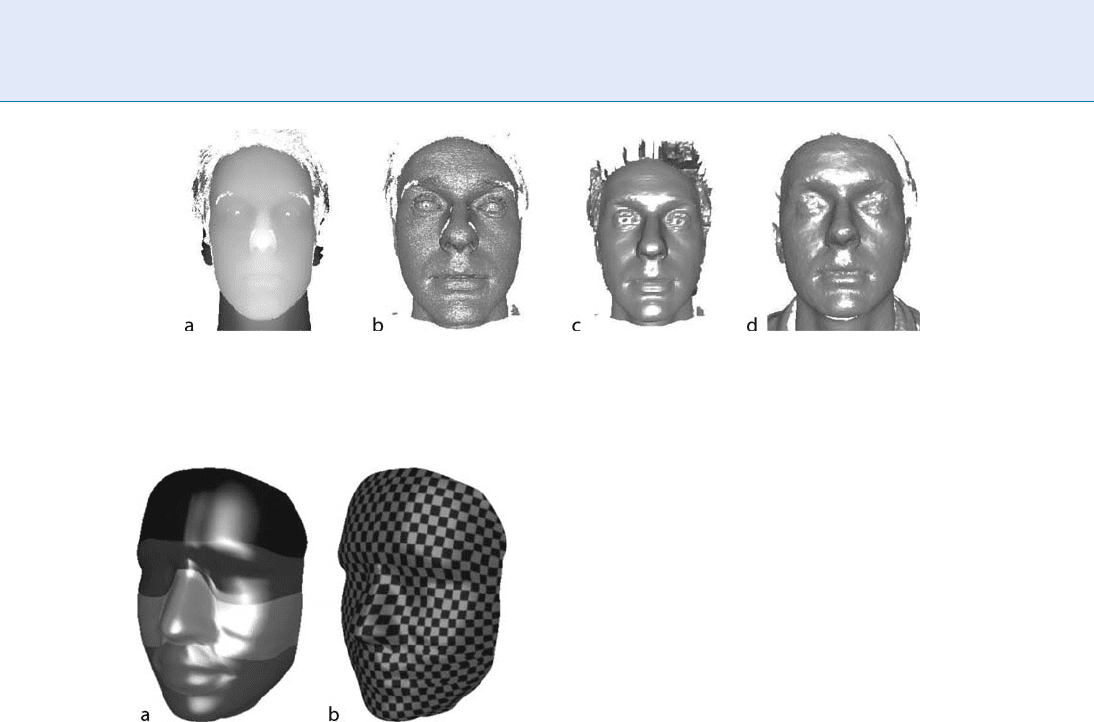
and metadata generation [1]. The model is anthropo-
metrically correct according to Farkas’ work [2], and
is annotated into different facial areas (e.g., mouth ,
nose, eyes) (Fig. 3). Apply ing a continuous global UV
parameterization on the model, all vertices of the
model from R
3
to R
2
and vice versa have been mapped.
Therefore, the model is defined both as polygonal data
in R
3
and as a geometry image in R
2
[1, 3].
A
▶ geometry image is a regular sampling of the
model represented as a 2D image with three channels,
each channel corresponding to the x, y, and z coordi-
nates of the 3D object. Since local neighborhoods on
the mesh are preserved (i.e ., neighboring vertices are
preserved even in the geometry image), an approxi-
mated version of the original mesh can be recon-
structed from the geometry image. The number of
channels in the geometry image can be greater than
three, as apart from geometric information, texture
and annotation can also be encoded.
Alignment
Our work on face recognition has indicated that
alignment (pose correction) is a key part of any
geometric approach. So, before fitting, align each
preprocessed dataset with the AFM. The alignment
stage computes a rigid transform, combining rota-
tion and translation, which brings the data as close
as possible to the model and is robust and accu-
rate even when relatively large deformations (facial
expressions) occur in the input data. Our align-
ment algorithm is a multi-stage algorithm which
propagates the alignment variables from one stage
to the next [1]. The first algo rithm is more resilient to
local minima, while the next two algorithms provide
greater alignment accuracy :
Spin images: The purpose of the first step is to
establish a plausible initial correspondence between
the model and the data. This step can be omitted if
the arbitrary rotations and translations in the data-
bases are not expected. A spin image is a represen-
tation of the geometric neighborhood around a
specific point [4]. To register two shapes, the cor-
respondences between the individual spin images
must be found. These correspondences are grouped
into geometrically consistent groups and the trans-
formations they yield are verified by checking if
they rotate the data by an acute angle (based on
the assumption that a given face does not have an
upside down pose or an opposite orientation from
the camera). This check is essential due to the bilat-
eral symmetry property of the human face.
Iterative closest point (ICP ): The main step of our
alignment process uses the ICP algorithm [5]
extended in a numbe r of ways. The ICP algorithm
Face Recognition, 3D-Based. Figure 3 AFM:
(a) Annotated facial areas and (b) texture used to
demonstrate parameterization.
Face Recognition, 3D-Based. Figure 2 Sensor-dependent preprocessing. Laser range scanner: ( a) input depth
image, (b) raw polygonal data (200,000 triangles), and (c) processed data (16K). Stereo camera: (d) raw data (34,000
triangles).
332
F
Face Recognition, 3D-Based

solves the registration problem by minimizing the
distance between the two sets of points. The anno-
tated model is exploited by assigning different
weights to different face regions. Additionally, pairs
containing points on surface boundaries are rejected.
This ensures that no residual error is introduced into
ICPs metric by the non-overlapping parts of two
surfaces. Finally, if the resulting transformation is
not satisfactory, the option of running the trimmed
ICP algorithm [6] is available.
Simulated annealing on z-buffers: This is a refine-
ment step that ensu res that the model and the data
are well aligned. The idea is to refine alignment by
minimizing the differences between the z-buffers of
the model and data. A global optimization tech-
nique has been employed, known as enhanced
simulated annealing (ESA) [7], to minimize the
z-buffer difference [8]. The higher accuracy of this
step can be attributed to the fact that the z-buffers
effectively resample the data which results in inde-
pendence from the data’s triangulation.
Deformable Model Fitting
The purpose of fitting the model to the data is to cap-
ture the geometric information of the desired object.
In order to fit the AFM to the raw data, a subdivision-
based deformable model framework [1] is used. When
the deformation concludes, the AFM acquires the
shape of the raw data. This establishes a dense corre-
spondence between the AFMs surface and the raw
data’s vertices. Additionally, since the deformation
has not violated the properties of the original AFM,
the deformed AFM can be converted to a geometry
image. The extracted geometry image encodes the geo-
metric information of the raw data (Fig. 4). Note that
the deformable model framework discards data not
belonging to the face and successfully handles artifacts
without any special preprocessing.
The fitting framework is an implementation of the
▶ elastically adaptive deformable models [9]usingsub-
division surfaces [10]. The Loop subdivision scheme
[11] has been selected since it produces a limit surface
with C
2
continuity, while only 1-neighborhood area
information is needed for each vertex. The AFM is
used as the subdivision surface’s control mesh, thus
determining the degrees of freedom, while the limit
surface is used to solve the following equation:
M
q
d
2
q
dt
2
þ D
q
dq
dt
þ K
q
q ¼ f
q
;
where q is the control points vector, M
q
is the mass
matrix, D
q
is the damping matrix, K
q
is the stiffness
matrix, and f
q
are the external forces. The external
forces drive the deformation. The stiffness matrix
defines the resistance agai nst the deformation, while
the mass and damping matrices control the velocity
and the acceleration of the vertices. This equation is
solved based on the finite element method (FEM)
approximation. During this process the AFM gradually
acquires the shape of the raw data.
Metadata Generation
The deformed model that is the output of the fitting
process is converted to a geom etry image, as depicted
in Fig. 4(c). The geometry image regularly samples the
deformed model’s surface and encodes this informa-
tion on a 2D grid. The grid resolution is correlated
with the resolution of the AFMs subdivision surface.
From the geometry image, a nor mal map image
(Fig. 4(d)) is also constructed. The normal map
Face Recognition, 3D-Based. Figure 4 Full face model after fitting: (a) Fitted model overlayed on the face data, (b) fitted
model geometry, (c) corresponding geometry image, and (d) corresponding normal map.
Face Recognition, 3D-Based
F
333
F
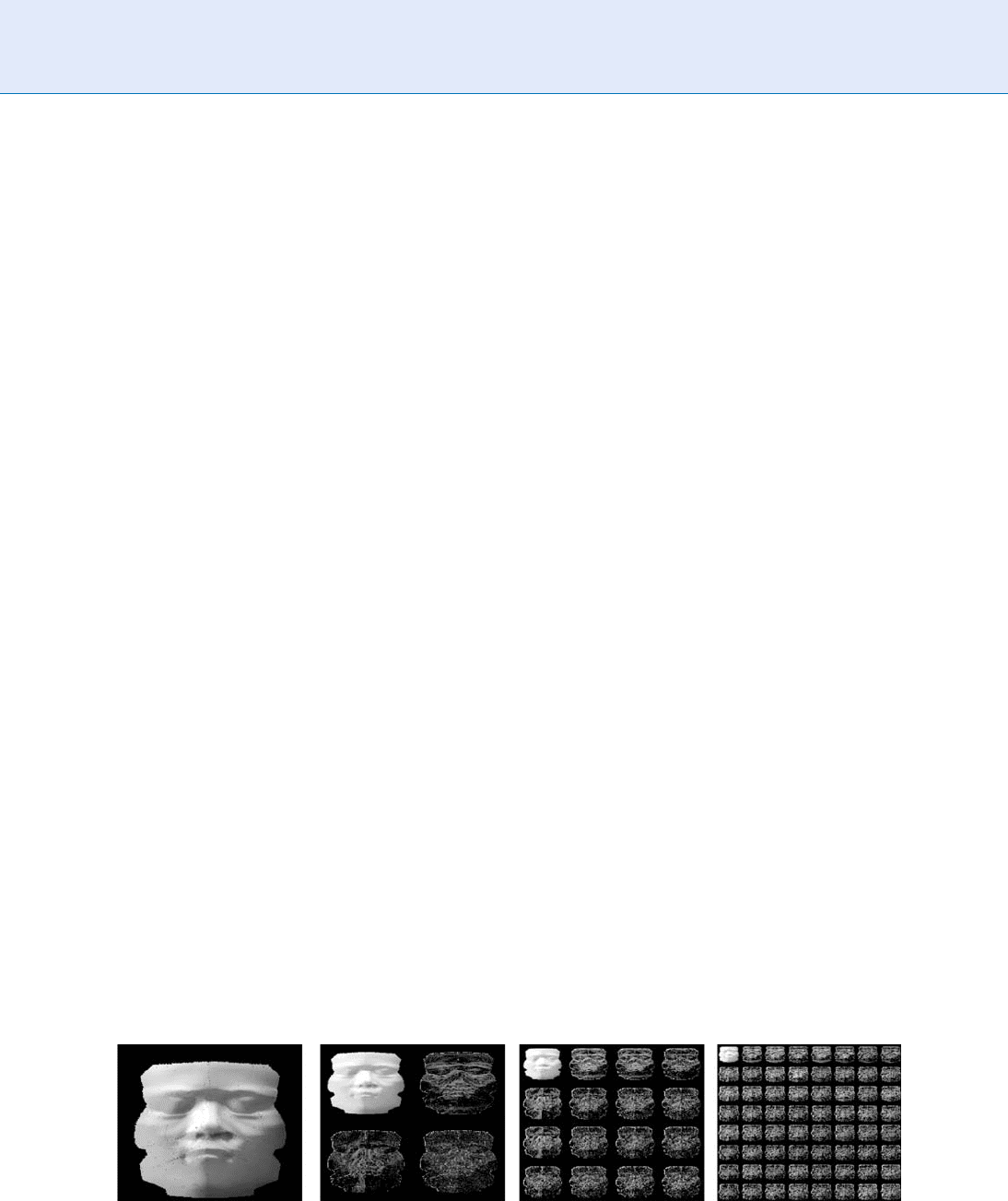
contains the 3D normal vectors to the surface as its
pixel values [1].
The three channels (components X, Y, and Z) of the
normal map and geometry image have been treated as
separate images. Each component is analyzed using a
wavelet transform and the coefficients are stored as
metadata. Two different transforms have been used,
the Haar and Pyramid transforms, thus obtaining two
sets of coefficients. The Pyramid transform is a more
computationally intensive transform, and therefore,
we may choose not to use it if the system needs to
be tuned for speed. The Haar transform is applied
on both the normal map and the geometry image,
while the Pyra mid transform is applied only on the
geometry image.
Haar wavelets: The choice of Haar wavelets was
based on their properties. The transform is concep-
tually simple and computationally efficient. The
Haar wavelet transform is performed by applying
a low-pass filter and a high-pass filter on a one-
dimensional input, and then repeating the process
on the two resulting outputs. Since we are working
with images, there will be four outputs for each
level of the Haar wavelet (Low–Low, Low–High,
High–High, High–Low). A level 4 decomposition is
computed, meaning that the filters are applied four
times, which yields 256 (16 16) wavelet packets
(Fig. 5). Each packet contains a different amount of
energy from the initial image. It is possible to
ignore most of the packets without losing signi-
ficant information and store the same subset of
the most significant coefficients as metadata. This
allows an efficient direct comparison of coefficients
of two images without the need for reconstruction.
Pyramid transform: The second transform decom-
poses the images using the complex version of the
steerable pyramid transform [12], a linear, multi-
scaled, multi-orientation image decomposition
algorithm. The resultant representation is trans-
lation-invariant and rotation-invariant. This fea-
ture is desirable to address possible positional
and rotational displacements caused by facial exp-
ressions. To maintain reasonable image resolution
and computational complexity, our algorithm
applies a 3-scale, 10-orientation complex steerable
pyramid transform to decompose each chann el
of the geometry image. Only the low-pass orienta-
tion subbands at the farthest scale are stored as
metadata. This enables us to compare the subband
coefficients of two images directly without the
overhead of reconstruction.
Distance Metrics
In the recognition phase, the comparison between two
subjects (gallery and probe) is performed using the
metadata information. The coefficients of the geome-
try image are kept as metadata, and the normal map of
each dataset. Additionally, there may be two coefficient
types for each: the Haar coefficients and, optionally,
the Pyramid coefficients. To compare the metadata,
there is a need to define a distance metric for each
type of coefficient:
Haar metric: In the case of Haar wavelets, the
metric used is weighted L
1
on each component
independently. The total distance is the sum of
the distances computed on all components.
Pyramid metric: A modified version of the complex
version of the structural similarity index (CW-SSIM)
[13] is used. CW-SSIM iteratively measures the
similarit y indices between two sliding windows
Face Recognition, 3D-Based. Figure 5 Haar wavelet analysis for the normal map image: (a) zero level, (b) first level,
(c) second level, (d) third level. Note that the real numbers were mapped to a gamma corrected grey-scale for
visualization purposes.
334
F
Face Recognition, 3D-Based

placed in the same positions on the two images, and
uses the weighted sum as a final similarity score.
Fusion: When both types of coefficients are used,
the distances given by the Haar and the Pyramid
metrics are fused. A weighted sum of the two dis-
tances is used as a fusing score.
3D Face Recognition Hardware
Prototype System
A field-deployable prototype system has been built and
is operational at the University of Houston. It consists
of a 3dMD
TM
3D camera (1-pod configuration) which
is connected to a laptop. The color camera of the pod
captures a continuous video stream which is used to
detect whether a person is facing the 3D camera. When
the subject is facing the camera and remains relatively
still for more than 2 s, the system triggers the 3D
camera and the geometry data of the individual’s
face are captured. Each of the cameras has a resolution
of 1.2 megapixels. The entire capture process takes
less than 2 ms, and it produces a mesh with less than
0.5 mm RMS error (as quoted by the manufacturer).
The system can either enroll the subject into the
database or perform a scenario-specific task. In an
identification scenario, the system will display the clos-
est five datasets to the operator. In a verification sce-
nario, the system will deter mine whether the subject is
who he/she claims to be, based on a preset distance
threshold.
The system’s field-deployable characteristics are:
Automation: All methods utilized are fully auto-
mated, requiring no interaction with a user. The
system is capable of detecting when a subject is
within range by using a face detector implementa-
tion, and initiating the enrollment or authentica-
tion procedures automatically.
Space efficiency : The raw 3D data produced by most
scanners are of several MB. After the enrollment
phase, the system needs to keep only the metadata.
Time efficiency : The enrollment phase is the most
time consuming, as the time delay to convert the
raw scanner data to the final metadata is 15 s. In the
authentication phase of an identification or verifi-
cation scenario, only the stored metadata are uti-
lized. The system can compare the metadata of
enrolled subjects at a rate of 1,000/s on a typical
modern PC (3.0 GHz P4, 1 GB RAM).
Performance Evaluation
Databases
The results on 3D face recognition are reported using
two databases. The first is the well known FRGC v2
database and the second is a collection of 3D faces
acquired at the University of Houston (UH). To dem-
onstrate the sensor-invariant nature of the proposed
system, the UH database is combined with FRGC v2.
The FRGC v2 database [14, 15] contains 4,007 3D
scans of 466 persons. The data were acquired using a
Minolta 910 laser scanner that produces range images
with a resolution of 640480. The scans were acquired
in a controlled environment and contain various facial
expressions (e.g., happiness or surprise). The subjects
are 57% male and 43% female, with the following age
distribution: 65% 18–22 years old, 18% 23–27 and
17% 28 years or over. The database contains annota-
tion information, such as gender and type of facial
expression.
The UH database contains 884 3D facial datasets
acquired using our 3dMD
TM
system (with 1-pod and
2-pod setups) over a period of one year. The data
acquisition protocol was the following:
For each subject:
Remove any accessories (e.g., glasses).
Acquire a dataset with neutra l expression.
Acquire several datasets while the subject reads
loudly a predefined text (thus assuming facial
expressions).
Put on the accessories and acquire a dataset with
neutral expression.
The UH database is more challenging compared to the
FRGC v2 as the subjects were encouraged to assume
various extreme facial expressions and in some cases
accessories were present. The resulting extended data-
base contains a total of 4,891 datasets, 82% acquired
using a laser scanner, 18% acquired using an optical
camera, and, to the best of our knowledge, is the largest
3D facial database reported.
Performance Metrics
Two different scenarios have been em ployed fo r the
experiments: identification and verification. In an iden-
tification scenario, divide the database into probe and
gallery sets so that each subject in the probe set has
Face Recognition, 3D-Based
F
335
F

exactly one match in the gallery set. To achieve this, use
the first dataset of every individual as gallery and the
rest as probes. The performance is measured using a
cumulative match characteristic (CMC) curve and the
rank-one recognition rate is reported.
In the verification scenario, measure the verifica-
tion rate at 0.001 false accept rate (FAR). The verification
rate is defined as the fraction of datasets that are posi-
tive (e.g., claiming to be who they really are), and are
classified as positive. The FAR is defined as the fraction
of datasets that are negative (e.g., pretending to be
somebody else), but are classified as positive. The results
are plotted using a receiver operating characteristic
(ROC) curve which plots verification rate as a function
of FAR. The FRGC v2 database defines three possible
selections of datasets (referred to as ROC I, ROC II, and
ROC III). In ROC I, all the data are within semesters,
in ROC II, they are within one year, while in ROC III, the
samples are between semesters. These experiments are of
increasing difficulty.
Experiment 1: Wavelet Transforms
The purpose of this experiment is to evaluate the
performance of the two wavelet transform s, and to
provide a reference score on the FRGC v2 database.
Using a fusio n of the two transforms, our system
yielded a verification rate of 97.3% (for ROC I at
0.001 FAR), while separately for the Haar transform a
rate of 97.1% and for the Pyramid transform a rate
of 95.2% were achieved (Table 1).
Even though the Pyramid transform is computa-
tionally more expensive, it is outperformed by the
simpler Haar wavelet transform. This can be attributed
to the fact that in the current implemen tation, the
Pyramid transform utilizes only the geometry images
and not the normal map images. The fusio n of the two
transforms offers more descriptive power, yielding
higher scores, especially in the more difficult experi-
ments of ROC II and ROC III, as depicted in Table 1.
To the best of our knowledge, this is the highest per-
formance reported on the FRGC v2 database for the
3D modalit y.
Experiment 2: Facial Expressions
Facial expressions have traditionally decreased the
performance of face recognition systems. In this exper-
iment, the authors evaluate the impact of facial expres-
sions on the performance of the system. All datasets
in FRGC v2 are annotated, and one of the categories
recorded is the facial expression. The authors chose to
divide the database into two distinct sets: the first set
contains non-neutral facial expressions only, while the
second set contains datasets that were annotated as
having a neutral facial expression.
The performance of the two subsets is compared to
the performance on the entire set at 0.001 FAR in
Table 2. The average decrease of 1.56% in verification
between the full database and the subset containing
only facial expressions is very modest when compared
to most other systems, given the fact that this subset
contains the most challenging datasets from the entire
database and is fully automatic. The small decrease
in performance can be attributed to the use of the
deformable model framework and the AFM.
Experiment 3: Multiple Sensors
The purpose of this experiment is to evaluate the
performance of our system using data from multiple
sensors. Verification experiments depend heavily on
the pairs of datasets chosen for evaluation. In the
absence of any standard way of designing such experi-
ments, opt for an identification experi ment, which is
considered to be more representative and more easily
duplicated.
This identification experiment was conducted on
different databases: FRGC v2 database, with 466 gallery
and 3,541 probes (laser scanner), UH database with
Face Recognition, 3D-Based. Table 1 Verification rates of
our system at 0.001 far using different transforms on the
Frgc V2 database
ROC I ROC II ROC III
Fusion 97.3% 97.2% 97.0%
Haar 97.1% 96.8% 96.7%
Pyramid 95.2% 94.7% 94.1%
Face Recognition, 3D-Based. Table 2 Performance of our
system at 0.001 far on the full FRGC V2 database, on a
subset containing only non-neutral facial expressions and
on a subset containing only neutral expressions
ROC I ROC II ROC III
Full Database 97.3% 97.2% 97.0%
Non-neutral 95.6% 95.6% 95.6%
Neutral Expressions 99.0% 98.7% 98.5%
336
F
Face Recognition, 3D-Based
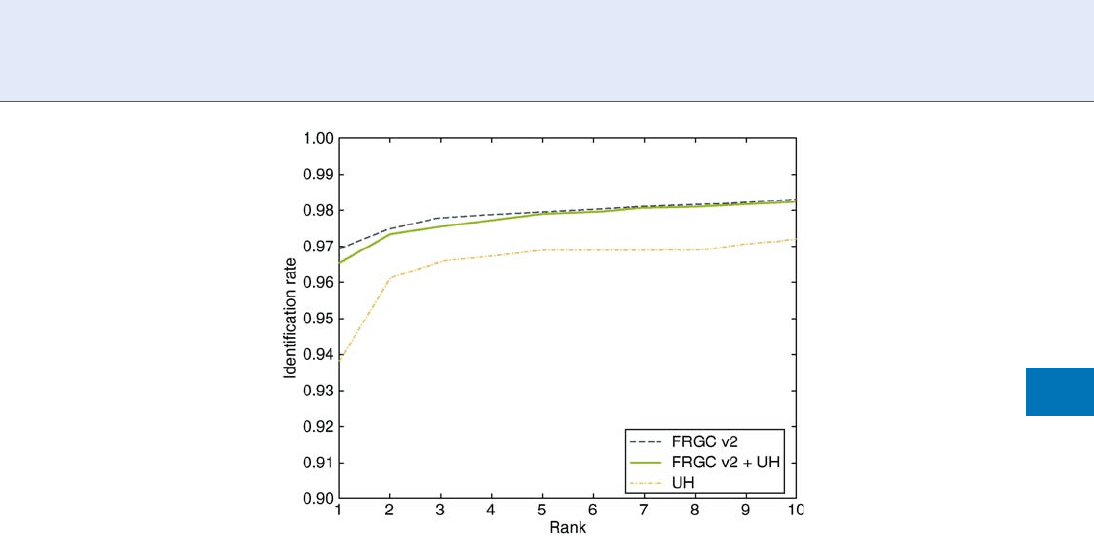
240 gallery and 644 probes (optical scanner) and FRGC
v2+UH database with 706 gallery and 4,185 probes
(both scanners). On the FRGC v2 dataset, the rank-
one identification rate was 97.0% , while for the UH set,
the system achieved 93.8%. Fig. 6 depicts the full CMC
curve. The combined experiment yielded a rank-one
recognition rate of 96.5%, which represents a drop in
performance of only 0.5% when compared to the orig-
inal FRGC v2 experiment, demonstrating the system’s
robustness when data from multiple sensors are
included in the same database.
Conclusion
The authors presented algorithmic solutions to the
majority of the challenges faced by field-deployable
3D facial recognition systems. By utilizing an anno-
tated deforma ble model, the 3D geometry information
is mapped onto a 2D regular grid, thus combining the
descriptiveness of 3D data with the computational
efficiency of 2D data. A multi-stage fully automatic
alignment algorithm and the advanced wavelet analysis
resulted in robust state-of-the-art performance on the
publicly available FRGC v2 database. Our multiple -
sensor database pushed the evaluation envelope one
step further, showing that both accuracy and robust-
ness can be achieved when data from different sensors
are present, through sensor-oriented preprocessing.
Proof of concept is provided by our prototype system
which combines competitive accuracy with storage
and time efficiency.
Related Entries
▶ Anatomy of Face
▶ Deformable Models
▶ Face Localization
▶ Face Pose Analysis
▶ Face Recognition: Component-based
▶ Face Recognition: Shape vs Appearance
References
1. Kakadiaris, I., Passalis, G., Toderici, G., Lu, Y., Karambatziakis, N.,
Murtuza, N., Theoharis, T.: 3D face recognition in the pre-
sence of facial expressions: an annotated deformable model
approach. IEEE Trans. Pattern Anal. Mach. Intell. 29(4),
640–649 (2007)
2. Farkas, L.: Anthropometry of the Head and Face. Raven Press,
NY (1994)
3. Gu, X., Gortler, S., Hoppe, H.: Geometry images. In: Proceed-
ings of SIGGRAPH, pp. 355–361, San Antonio, TX, USA, July
(2002)
4. Johnson, A.: Spin-images: a representation for 3-D surface
matching. Ph.D. Thesis, Robotics Institute, Carnegie Mellon
University, Pittsburgh, PA, August (1997)
Face Recognition, 3D-Based. Figure 6 System performance for identification experiment on different databases: FRGC
v2 database with 466 gallery and 3,541 probes (laser scanner), UH database with 240 gallery and 644 probes (optical
scanner) and FRGC v2+UH database with 706 gallery and 4,185 probes (both scanners).
Face Recognition, 3D-Based
F
337
F

5. Besl, P.J., McKay, N.D.: A method for registration of 3-D shapes.
IEEE Trans. Pattern Anal. Mach. Intell. 14(2), 239–256 (1992)
6. Chetverikov, D., Svirko, D., Stepanov, D., Krsek, P.: The
trimmed iterative closest point algorithm. In: Proceedings of
the International Conference on Pattern Recognition, vol. 3,
pp. 545–548. Quebec City, Canada (2002)
7. Siarry, P., Berthiau, G., Durbin, F., Haussy, J.: Enhanced simulated
annealing for globally minimizing functions of many-continuous
variables. ACM Trans. Math. Software 23(2), 209–228 (1997)
8. Papaioannou, G., Karabassi, E., Theoharis, T.: Reconstruction of
three-dimensional objects through matching of their parts. IEEE
Trans. Pattern Anal. Mach. Intell. 24(1), 114–124 (2002)
9. Metaxas, D., Kakadiaris, I.A.: Elastically adaptive deformable
models. IEEE Trans. Pattern Anal. Mach. Intell. 24(10),
1310–1321 (2002)
10. Mandal, C.: A dynamic framework for subdivision surfaces.
Ph.D. Thesis, University of Florida (1998)
11. Loop, C.: Smooth subdivision surfaces based on triangles. M.Sc.
Thesis, Department of Mathematics, University of Utah (1987)
12. Portilla, J., Simoncelli, E.P.: A parametric texture model based on
joint statistic of complex wavelet coefficients. Int. J. Comput.
Vis. 40, 49–71 (2000)
13. Wang, Z., Simoncelli, E.: Translation insensitive image similarity
in complex wavelet domain. In: Proceedings of the IEEE Inter-
national Conference on Acoustics, Speech and Signal Processing,
vol. II, pp. 573–576. Philadelphia, PA, USA (2005)
14. Phillips, P.J., Flynn, P.J., Scruggs, W.T., Bowyer, K.W., Chang, J.,
Hoffman, K., Marques, J., Min, J., Worek, W.: Overview of the
face recognition grand challenge. IEEE Computer Society Con-
ference on Computer Vision and Pattern Recognition, 2005.
CVPR 2005, vol. 1, pp. 947–954. Gaithersburg, MD, USA (2005)
15. Phillips, P.J., Scruggs, W.T., O’Tool e, A.J., Fly nn, P.J.,
Bowye r, K.W., Schott, C.L., Sharpe, M.: FRVT 2006 and ICE
2006 Large-Scale Results. NISTIR 7408, March (2007)
16. Kirkpatrick, S., Gelatt, C., Vecchi, M.: Optimization by
simulated annealing. Science 22(4598), 671–680 (1983)
Face Recognition,
Component-Based
ONUR C. H AMSICI,ALEIX M. MARTINEZ
The Ohio State University, Columbus, OH, USA
Synonyms
Face recognition using local features; Part-based face
recognition
Definition
A major problem in face recognition is to design algo-
rithms that are invariant to those image changes typically
observed when capturing faces in real environments.
A large group of important image variations can be
addressed using a component-based approach, where
each face is first analyzed by parts and then the results
are combined to provide a global solution. The image
variations that are generally tackled with this approach
are those due to occlusion, expression, and pose [1].
It has been argued that these changes have a lesser
effect on local regions than to the whole of face image.
Differences exist on how to formulate the component-
based approach. Some of the algorithms use local infor-
mation and combine these using a global decision
maker. Some extract the important local parts to repre-
sent the face distributions, while others learn the distri-
bution of the components generated by the variations.
A summary of these techniques is given in this essay.
Introduction
Component-based face recognition algorithms include
those that use some local information of the face to do
recognition of the whole. These algorithms are very
popular, since the local information is generally more
robust to many of the typically seen parameter varia-
tions of the face. This is especially true if one does
recognition based on the texture (i.e., pixel informa-
tion) of the face.
One of these parameters is the location of the
fiducial points in the face. These fiducial points are
necessary to align all faces with respect to one another.
However, it is not usually possible to obtain the exact
location of these points automatically. This generates
imprecise localizations which will further decrease
the performance of the recognition algorithms [1].
Component-based algorithms can also be made more
robust to these errors of localization. This is be cause
some of the local features may be l ocalized more pre-
cisely than the other ones and, hence, lead to better
recognition rates.
A similar advantage is also seen in expression and
pose changes. In this case, some local components of
the face may have less expression changes (such as the
nose region when a person smiles) or maybe less
affected by pose changes (such as the eye region that
is in the opposite side of the head).
Moreover, brightness changes are known to be
handled better when the face is represented by compo-
nents. It is because the face is a nonconcave structure,
resulting in different lightings across it. For example,
338
F
Face Recognition, Component-Based
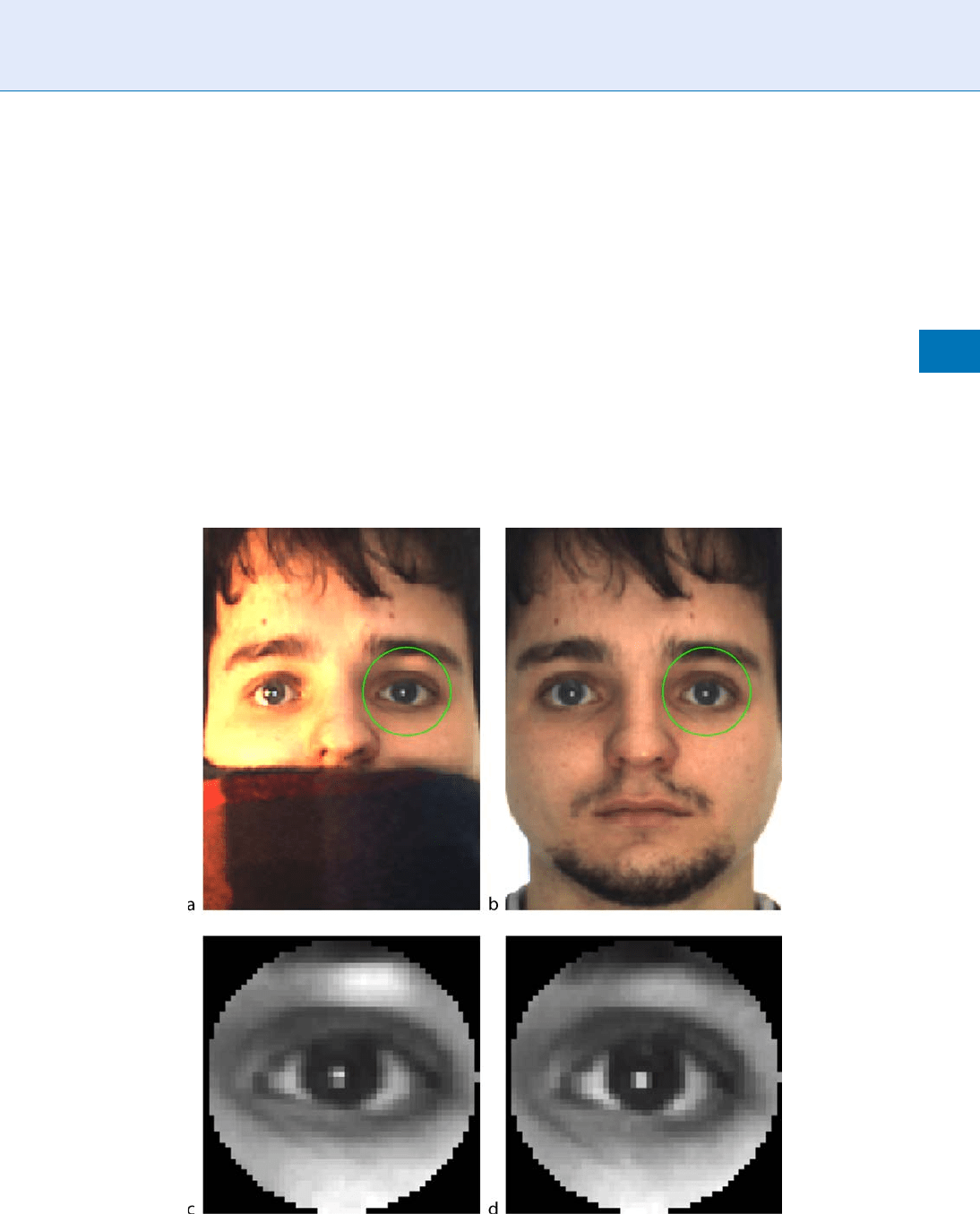
the right and left side of a face may be lighted with totally
different lighting conditions and, hence, may lead to
different pixel levels. Trying to handle these changes
using a global approach may fail due to the possible
lighting changes. Simple intensity normalization pro-
cesses can be used to eliminate part of the lighting differ-
ences when using a component-based approach [2].
Another advantage of using component-based algo-
rithms is the stability for the possible occlusions over the
faces. Even when half of the face is occluded, as for
example with a scarf or large eyeglass, a component-
based algorithm can still employ the information of the
other half of the face image to do recognition.
Figure 1 shows some of the advantages of the local
approach representation just described. Although,
there is an extreme lighting change and occlusion of
the face, the local right eye regions are very similar in
both images and shall lead to a successful classification.
Because of these advantages component-based face
recognition algorithms are preferred approaches in
many real settings. In the following sections some of
the most used algorithms defined thus far have been
investigated. A discussion as well as the pros and cons
of each technique , have also been provided.
Component-Based Face Recognition
Component-Based Graphs
Building a system that is not skewed by localization errors
seems close to impossible. This is due to the many
Face Recognition, Component-Based. Figure 1 Although the faces shown in (a) and (b) have extreme lighting changes
and occlusions, the corresponding right eye regions in (c) and (d) are very similar.
Face Recognition, Component-Based
F
339
F
